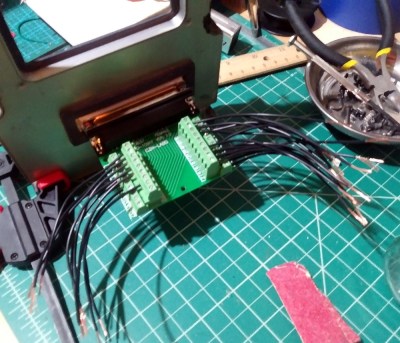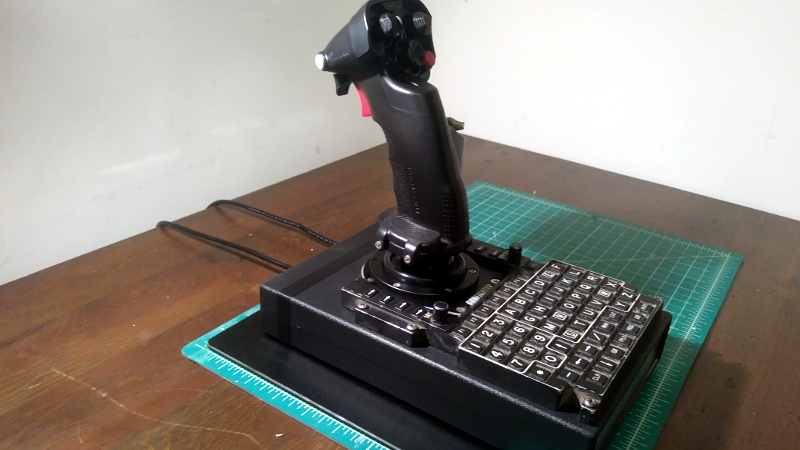If you’re looking to add some realism to your flight setup without converting the guest bedroom into a full-scale cockpit simulator, you might be interested in the compromise [MelkorsGreatestHits] came up with. He bolted a genuine military keypad to his PC joystick and instantly added 100% more Top Gun to his desktop.
 The Rockwell Collins manufactured keypad came from eBay, and appears to have been used in aircraft such as the EA-6B Prowler and Lockheed C-130 Hercules for data input. Each key on the pad is wired to the 37 pin connector on the rear, which [MelkorsGreatestHits] eventually mapped out after some painstaking work with a breakout board.
The Rockwell Collins manufactured keypad came from eBay, and appears to have been used in aircraft such as the EA-6B Prowler and Lockheed C-130 Hercules for data input. Each key on the pad is wired to the 37 pin connector on the rear, which [MelkorsGreatestHits] eventually mapped out after some painstaking work with a breakout board.
Once the matrix was figured out, he made up a cable that would go from the connector to a Teensy 2.0 microcontroller. The Teensy reads the keypad status and converts button presses over to standard USB HID that can be picked up in any game.
The joystick side of the build is a VKB Gunfighter, which is already a pretty nice piece of kit on its own. No modifications were necessary to the joystick itself, other than the fact that it’s now mounted to the top of a black project enclosure. It still connects directly to the computer via its original USB cable, as the keypad has its own separate connection. As luck would have it, the joystick is almost a perfect fit in the opening on the keypad, which presumably would have been for a small screen when installed in the aircraft.
Finding cockpit components from military aircraft on eBay is not as hard as you may think; something to keep in mind if you ever decide to tackle that custom flight simulator build.
















I sometimes wonder if people who grow up playing today’s gazillion-button video games end up developing a slightly different brain structure than those of us who grew up with the NES or earlier. I’m not saying it’s a bad thing…
Do force feedback joysticks still exist and have drivers? Cool idea!
No, they don’t. Patent trolls have the tech locked up. The last true force feedback joystick was the Logitech G940, which was super cool and didn’t even have centering springs; It used the FF motors to center the stick!
It looks great, though the ergonomics of placing a keypad behind the stick is a bit suspect.
behind the stick? isn’t it in front?
Interesting thought. I think it depends on your frame of reference. People around my area would say that you’re behind the wheel when you’re driving a car. A car has a front and a rear. If you were standing behind the car and looking at the rear you wouldn’t say the rear bumper is in front of the steering wheel. It’s behind it. But if you took the bumper and the wheel off the car completely and set them on the ground with the bumper between you and the wheel then you could say that the bumper is in front of the wheel. At that point most people probably wouldn’t consider the two items to be one unit with a direction, or a front and a rear. With this flight stick you could probably still argue it either way simply because different people will look at it differently.
I take that last part back. Because the stick is directional, the pad would be behind it.
You would not use that keyboard during maneuvered flight. I suspect it will only be used when entering waypoints in the autopilot.
Cool! Apparently in the early 1960’s they hooked up the right arm panel of a military surplus Bomarc missile control console to play Spacewar! because they didn’t want to wear out the switches on the front of MIT’s PDP-1.
Interesting that the keyboard is not QWERTY
Even today, you will find new devices non-qwerty keyboards, namely all kinds of handleld terminals/laser scanners
Typing is a learned skill. as is the layout of the letters in the alphabet.
Difference being you don’t get past first grade without knowing the alphabet while it was still very common until and even past the the last 90s for a high school graduate to be incabale of touch typing.
Touch typing proficiency is required to know where the keys are located on a qwerty layout and thus takes very precious time for a non-initiate to locate letters that both typists and non typists can locate in an alphabetic layout.
Military systems must be desinged for the lowest skillset endowed person that would be permitted to use the equipment, not the average.